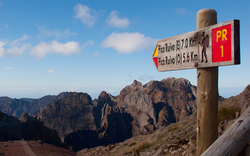
Madeira Island
 |  |  |  |
|---|---|---|---|
 |  |  |  |
 |  |  |  |
 |  |  |  |
 |  |  |  |
 |  |  |  |
 |  |  |  |
 |  |  |  |
 |  |  |  |
 |
The island of Madeira has a surface area of 459 square miles (741 km2), (35 miles long and 13 miles wide).
Thanks to their excellent geographical location and mountainous relief, these islands have surprisingly balmy weather, with moderate humidity and pleasant average temperatures of 25ºC in the summer and 17ºC in the winter.
The sea temperature is also very mild, thanks to the influence of the warm Gulf Stream, averaging 22ºC in the summer and 18ºC in the winter.
The archipelago is located in the African Plate in the Atlantic Ocean between latitude 30 ° and 33 °N, basically at the same latitude as Casablanca, 978 km southwest of Lisbon, about 700 km west of the African coast, and 450 km north of the Canary Islands.
This archipelago is formed by the Madeira Island with an area of 741 km², Porto Santo with 42.5 km², the Desertas Islands with a total of 14.2 km² comprising the three uninhabited islands, and by the Selvagens Islands whose set of 3 islands and sixteen uninhabited islets make up an area of 3.6 km². Of the eight islands, only the two largest (Madeira and Porto Santo) are inhabited and can be accessed via the Madeira Airport in Funchal and Porto Santo Airport.
Funchal, the capital city of Madeira, has access by sea, through a port with a modern station that stands out on the national scene, with regard to cruising. More than half a million passengers disembark here per year. The remaining islands are nature reserves.
For hundreds of years, Funchal was the only city of the Autonomous Region of Madeira, until 5 other cities gained this status between the end of the twentieth century and the beginning of the next century: Câmara de Lobos, Caniço, Machico, Santana and Vila Baleira.
The island of Madeira has a very rugged terrain, with the highest point being Pico Ruivo (1,862 m), the Pico das Torres (1,851 m) and Pico do Arieiro (1,818 m), respectively the third, fourth and fifth highest points of Portugal. The northern coast is dominated by high cliffs and in the western part of the island you find a plateau region, the Paul da Serra with altitudes between 1,300 and 1,500 m.
The geological history of the archipelago of Madeira is closely related to the opening and expansion of the Atlantic Ocean, a process that began about 200 million years ago and continues to this day moving at a speed of about 2 cm/year. The archipelago is an example of intraplate volcanism- hot-spot - in an oceanic environment, resulting from the performance of two mantle plumes, one from which Porto Santo arose in mid Miocene, about 14 Ma, and later Madeira and the Desertas in the upper Miocene, about 7 Ma, and another that gave rise to the Selvagens Islands in the Oligocene, about 28 Ma.
The island of Madeira rises above a vast undersea plain, within the African plate, forming a volcanic massif over 5.5 km high, of which only one third is emerged.
The island has evolved through successive phases of intense volcanic activity separated by periods of very attenuated activity or inactivity, during which erosion reduced, sometimes dramatically, the size of the volcanic structure. During periods of intense erosion valleys were carved and rough reliefs were created destroying partially or totally volcanic forms, while the products of erosion were deposited on the immersed sides of the volcano or in the valleys. The resumption of activity during the following volcanic season led to fossilization of detrital sedimentary materials and of erosive reliefs. The most recent volcanic stratigraphy unit of Madeira, which occurred 6000-7000 years ago, represents the rejuvenation phase, characterized by volcanism implanted on an erosive topography on the shapes created in the previous stage. It is considered that the island of Madeira is still at this stage of evolution, and the volcanic activity is in a temporarily dormant state.